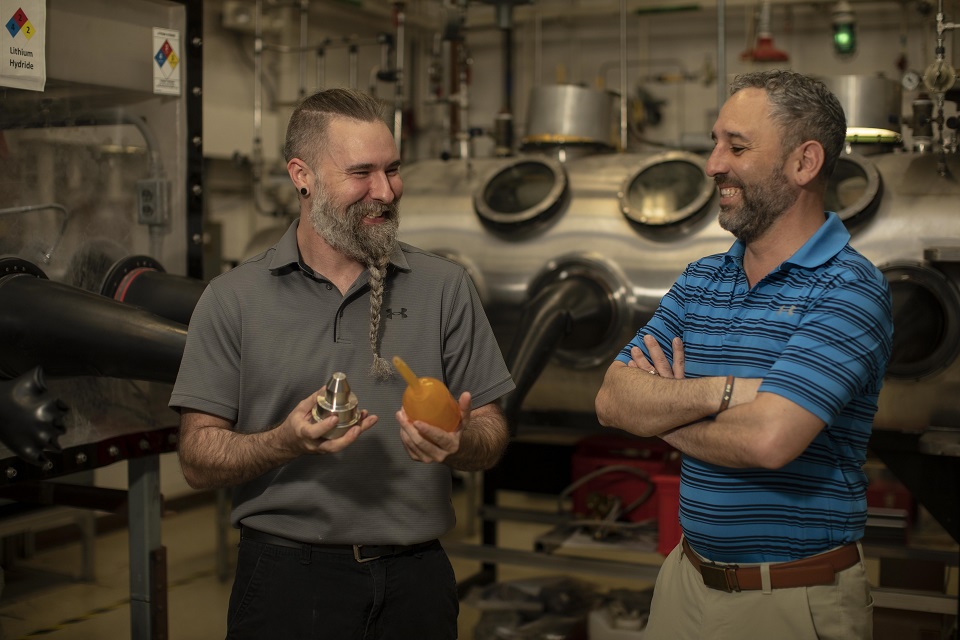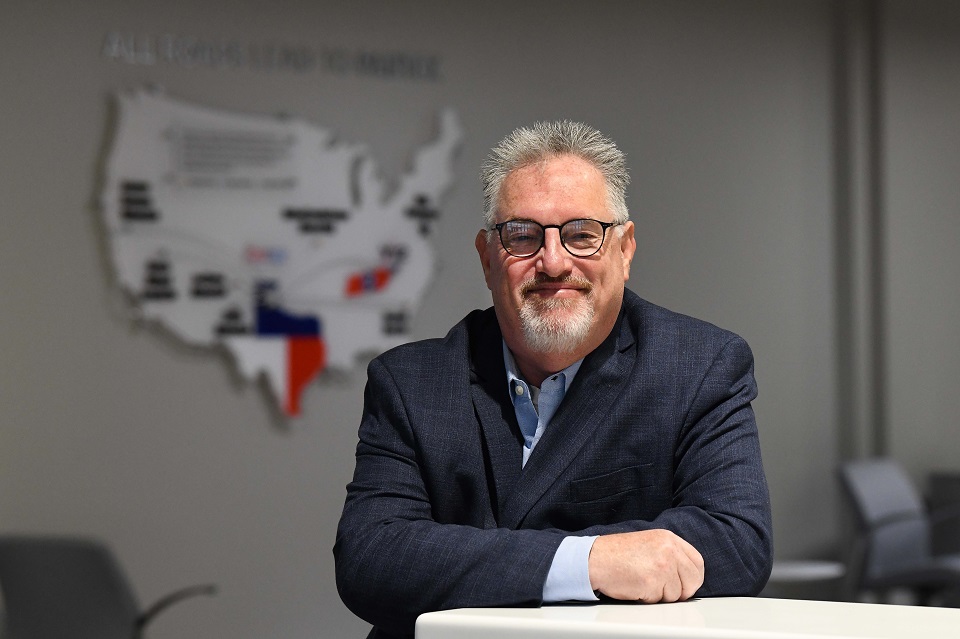Passing the PDRD baton

Mike Ellis (right), a 20-year Y-12 employee, is the new program manager for Y-12’s Plant Directed Research and Development program and is acting in the same role at Pantex. Ellis and Elijah Barlow (left) discuss a process being investigated for use with Y-12’s lithium stream.
It’s not easy to replace someone who retires from Pantex or Y-12 and takes with them multiple years of knowledge, but retirements happen and Consolidated Nuclear Security invests significant time and energy in Knowledge Preservation Management. Since February, two long-time leaders have retired from the Plant Directed Research and Development (PDRD) program, taking almost 80 years of combined history with them. Y-12’s Eric Larson retired in February, and Pantex’s Gregg Chambliss retired in May, but the future remains bright for PDRD.
Mike Ellis is the new Y-12 PDRD program manager and is acting in the same role at Pantex until Chambliss’ replacement is named. “I am fortunate to know Eric and Gregg as colleagues and friends,” Ellis said. “I had the opportunity to talk to Eric about the program, what was ahead, and our current portfolio (that includes 102 projects across both sites). I also have talked with and learned from Gregg. It was good to have that opportunity.”

Pantex’s Gregg Chambliss is now a retiree, but he has great expectations for the Pantex and Y 12 Plant Directed Research Program he leaves behind.
Chambliss, who had been the Pantex PDRD program manager since 2013, was happy to share his wisdom with Ellis, and has great expectations for the team. “Through PDRD, Pantex has been able to develop and replace obsolescent technologies that in some cases had gone far beyond the original life expectancy. It has been exciting to see numerous inventions submitted by Pantexans. Many of these have moved toward the possibility of becoming intellectual property or patents.”
Marina Yeary, director of Technology Development and Transfer, the organization under which PDRD falls, said, “PDRD develops technology solutions through research and development to meet current and future mission needs. The program provides a unique avenue to explore innovative scientific, engineering, and manufacturing ideas identified by site stakeholders — our employees.”
The impact of PDRD
PDRD touches many organizations and areas at the sites, including external partnerships. Grant Allard, program manager of Partnerships, said, “University and industrial partners are important resources for Pantex and Y-12 PDRD projects because they bring new ideas, novel resources, and world class expertise in supporting PDRD's mission of ensuring the sites’ technological and workforce vitality. Our higher education partners positively impact our vital national security mission by providing support to PDRD projects that cover every aspect of our sites, including how we process material streams that support operations, transform and maintain our infrastructure, enhance our global security and nonproliferation capabilities, and digitally transform to enable data driven operations.”
One such development Chambliss saw during his tenure was the Computer Numerical Control/Controller Mill Lathe Machining Center.
“This new machine was designed by Pantexan Jeff Yokum,” Chambliss explained. “He worked with the vendor to finalize the ‘build.’ This new capability revolutionized the way we machine high explosive billets, as well as minimized the footprint for this machine.”
The CNC replaced several different machines that do the same tasks, but it operates in a safer manner. Chambliss said, “It minimizes the technician’s handling of the product, and the machine also solved a production bottleneck within the machining workload for the High Explosives Manufacturing organization.”
One Y-12 example Ellis shared is the electrorefining technology that was introduced with thePDRD program in 2008.
“The Development organization has great researchers at both sites who work closely with the PDRD team and executing organizations. Communicating and understanding upcoming needs are top concerns, so we work to hire the right people for what we need,” Ellis said.

Y-12’s Eric Larson retired in February and Mike Ellis took the role of PDRD program manager.
Yeary said, “PDRD enables CNS to maintain an environment of robust technology and innovation that not only significantly improves the effectiveness and efficiency of our mission, but also attracts engineering and scientific talent necessary to ensure a future workforce capable of the unique expertise required by the mission.”
Ellis said, “We require very specific skillsets, and want to leverage the program to retain and grow our employees. PDRD provides employees an exciting opportunity and allows them to work on cutting edge technologies and ideas.”
Jennifer Palmer, Technology Transfer program manager, said, “Pantex and Y-12 have demonstrated the transformational nature of PDRD by delivering real world solutions already proven in the production environment. From implementing and scaling up next generation manufacturing systems, through the integration of robotics, automation, controls, and machine tools, the results can provide critical cost effective solutions and enable subsequent technology commercialization and adoption.”
“It’s been great to learn from Eric and Gregg,” Ellis said. “They were great mentors for me, and we have an amazing team in PDRD — that can’t be stated enough. I’m excited about the growth we’ve had for the past several years and the planned growth from now through 2028. I’m enthused to be able to participate and be an advocate for both Pantex and Y-12. We’re seeing impressive things with more great days ahead for PDRD.”
